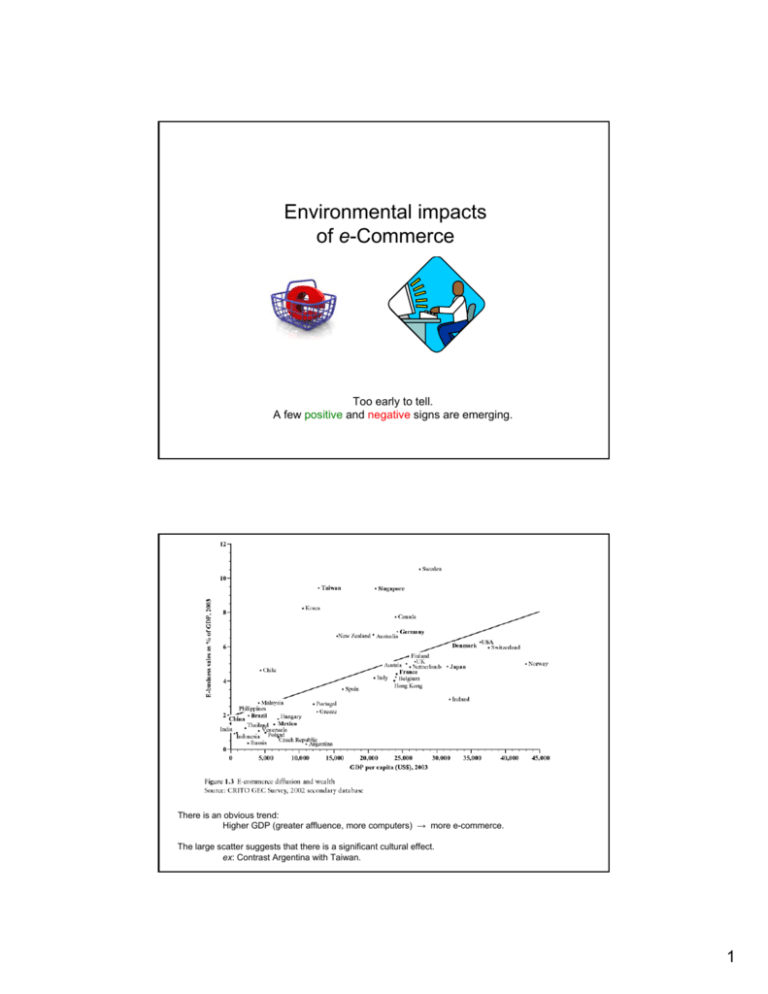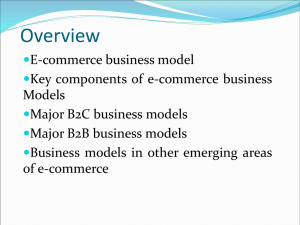Environmental impacts of e
advertisement

Environmental impacts of e-Commerce Too early to tell. A few positive and negative signs are emerging. There is an obvious trend: Higher GDP (greater affluence, more computers) → more e-commerce. The large scatter suggests that there is a significant cultural effect. ex: Contrast Argentina with Taiwan. 1 “A lot of Americans did their holiday shopping on the Internet. We heard a lot about that on the evening news last December. The evening news, along with The Washington Post, told us something else about our use of the Internet — it seems to be making us more energy efficient. According to a report by the nonprofit Center for Energy and Climate Solutions, it is possible that information technology, and the Internet in particular, are making the economy somewhat less dependent on energy.” (Source: Energy Information Administration, DoE) How can we tell? e-Commerce represents both an opportunity and a threat to international trade and the environment. Currently, there is no substantial data to support either position. In addition, there are no policies or regulations that are specifically designed for environmental issues in e-commerce. (Source: Eric Letvin, Greenhorne & O'Mara, Greenbelt, MD) Billion-dollar days build holiday cheer as the web outshines stores in sales gains Don Davis , Editor As the all-important holiday shopping season wore on, the differences between offline and online stores became increasingly apparent: While bricks-and-mortar stores started off well with a 6.7% yearover-year rise in November sales, non-store, mostly web, sales rose at double that pace, increasing 13.9%, according to the U.S. Department of Commerce. Through mid-December, holiday season e-commerce sales remained nearly 15% ahead of the 2010 holiday season, as sales for Nov. 1 through Sunday, Dec. 18, totaled $31.97 billion, up 14.95% from $27.81 billion in the comparable 2010 period, according to comScore, which makes estimates based on tracking the online activity of a panel of 1 million U.S. consumers. http://www.internetretailer.com/mobile/2011/12/31/billion-dollar-days-build-holiday-cheer 2 First-order effects – due to IT infrastructure and its direct use Cause: Manufacture, use and disposal of equipment Effects: → Chemicals, hazardous substances, workers’ exposure → Electricity consumption → Electronic waste to recycle or otherwise dispose of Difficulty: Hard to assess the fraction of computer use dedicated to internet shopping Second-order effects – due to changes in activities and markets Cause: Online orders, digitization of products Economic effects: → Change in supply chain, stores → warehouses → On-time delivery → smaller warehouses → Company decentralization → more communications (phones, faxes) → Transportation of freight: smaller packages, more by air Environmental effects: → Dematerialization (ex. digitization of books) → Change in land use (fewer malls, more warehouses) → Transport volume, vehicle emissions → More packaging but more plain Health effects: → carpal tunnel syndrome, spine injury, eye strain, etc. → lack of exercise, obesity 3 Third-order effects – due to subsequent rebound effects Economic changes: → Change in competition → change in price structure → change in consumption patterns Environmental changes: → Changes in material flows → Changes in energy use → Changes in transportation infrastructure (airports just for freight) → Changes in land use location (from suburban shopping malls to warehouses near major roads) Also, people save time by shopping on line. This begs the question: How do they spend the freed time? → Those activities most likely have some environmental impact… Then, if people save money by buying online, Where else do they spend the extra money? Or, if people do spend more on shopping because of e-commerce, Where do they save the money to pay for those extra purchases? → Those previous activities most likely had environmental impacts, now avoided. Due to the simultaneous increased in environmental awareness and the increased ease of browsing, we note → Increased purchases of environmentally conscious products This in turn causes an environmental improvement but at cost of increased electronics infrastructure → Is there a net environmental improvement? If e-banking and online filing of tax returns supplement rather than replace the conventional activity → Increased impact … at least for the moment → What is the long-term prognosis? 4 To start discerning the impacts, it is helpful to use the following categories of activities: B2B B2C B2G C2B C2C C2G G2B G2C G2G where B = Business C = Consumer G = Government 2 = “to” More refined distinction: e-Commerce types represent a range of various schemas of transactions which are distinguished according to their participants. Business-to-Business (B2B) Business-to-Consumer (B2C) Business-to-Employee (B2E) Business-to-Government (B2G) (also known as Business to Administration or B2A) Business-to-Machines (B2M) Consumer-to-Business (C2B) Consumer-to-Consumer (С2C) Citizen-to-Government (C2G) (also known as Consumer-to-Administration or C2A) Government-to-Business (G2B) Government-to-Citizen (G2C) Government-to-Employee (G2E) Government-to-Government (G2G) Manager-to-Consumer (M2C) Peer-to-Peer (P2P) http://en.wikipedia.org/wiki/Electronic_commerce (older version) B2B Business-to-Business transactions by internet are estimated to account for 80% of the business transactions, such as ordering parts and supplies confirming receipts of deliveries taking orders and confirming their shipment communications with remote offices and contractors (ex. advertising firm) tracking inventories monitoring of remote activities (building sensors, fuel consumption) stock sales etc. Economic value of these transactions is estimated at $17 trillion/year worldwide and rising. The net effect is to replace human travel and paper documents by electronic information exchange → dematerialization, as direct effect. Other benefits: orders in precise amount orders just in time finer control of inventories → reduction in warehousing → reduction in energy use and land use better logistics → less transportation All this seems to be going in the greener direction. 5 B2B – continued Internet also allows business to post available by-products, excess products, etc. → Construction and dissemination of databases that are used for quicker sales of surpluses (instead of prolonged warehousing), sales of by-products (instead of paying for disposal), increased information on recycling possibilities, increased awareness of satellite business opportunities (filling gaps). Internet transactions also increase the speed of the activity → Less spoilage of perishables → Less waste Idem: Greener. Can you think of any other? B2B – end Note that in all these B2B activities, the driving force is NOT better environmental health! Rather, the mighty dollar is the primary incentive manifested in acceleration of business activities → increased efficiency lowering cost of transaction → direct savings opening of new markets → new sources of revenues Occasionally, environmental considerations play a subsidiary role, such as when offering a line of green products to enter a new market seeking differentiation from a non-green competitor. Since $$$ dictates business behavior, it is crucial to ensure that economic incentives are aligned with environmental stewardship. Sometimes, this may be forced by the government through fee structures, taxes & subsidies, cap-n-trade programs, etc. 6 B2C Examples: Amazon.com, online clothing retailers, online travel bookings, etc. The net environmental outcome is extremely difficult to assess. The devil lies in the details - miles to store - driving an SUV or riding a bicycle to the store - overnight shipment or not? - FedEX and UPS logistics are key to the answer but company secrets. Early, tentative answers show that the outcome appears to be mixed for BOOKS and positive for GROCERIES. Big question: Is consumerism growing with increased convenience? Can’t tell yet for internet “Business at the speed of thought” (Bill Gates) → Frivolous purchases? Historical precedent: personal car → suburbs → more cars, bigger houses, roads 7 B2C – continued Comparison that needs to be done: RETAIL AT SHOPPING MALL INTERNET PURCHASING Need for a mall → land & parking → store & lighting Only a warehouse → less land → almost no parking → less lighting Car travel to mall → air emissions Trip to mall avoided, or is it? Box packaging to mall in larger container Main packaging of product = fancy Additional packaging at purchase point = simple Same to warehouse, except fewer steps No need for fancy product package Much more individual packaging (x 2 ½) Return of unsold items to wholesaler No unsold item to return Recycling of cardboard boxes by store Low rate of package recycling from individuals Study by Lester Lave on Harry Potter’s new book: If < 5 miles to mall → in-store purchase better If > 5 miles to mall → internet purchase better (assuming 35% return of unsold books to publisher and many other assumptions) B2C – continued Miscellaneous environmental benefits: Computer manufacturers (incl. HP) post remanufactured items on the web This sales of one-of-a-kind object would not be possible without the internet → More re-use and less environmental impact. A web site can provide far more environmental information on the product than a mere label can do on a package. This allows environmentally savvy consumers to get the information they seek and make purchase with less uncertainty → more truly green products being sold → fake green products weeded out. Internet has made possible the sale of niche items with economy of scale. What about the environmental impacts of these new products? 8 B2C – continued Where is this all going? Among external factors, competitive pressure is a relatively important driver of demand. Government promotion and incentives have little impact, suggesting that e-commerce is mainly driven by market forces. However, the impacts of government policy are greater for developing countries, where there may be fewer resources or market incentives to go online. Survey data show that companies are more likely to respond to customer pressure (37%) than to supplier pressure (22%), suggesting that e-commerce adoption is “pulled” rather than “pushed” through the value chain. Global e-Commerce – Impacts of National Environment and Policy K.L. Kraemer, J. Dedrick, N. P. Melville & K. Zhu, editors Cambridge University Press, 2006. Toward an e-commerce code for manufacturers: Deeper design Shallower actions Managers in manufacturing companies can address environmental impacts by committing their companies to 1. 2. 3. 4. 5. 6. 7. Encourage electronic payments Advertise online Place instruction manuals on line Encourage shippers to use alternative fuels Use the most efficient product delivery system Move toward more environmentally sound packaging Do comparative life-cycle analysis before deciding to open a new store or warehouse 8. Work with delivery companies to institute packaging and product take-back 9. Design products that are efficient to ship (ex. concentrates) 10. Develop a consistent set of criteria and measures to define the environmental characteristic of their product 11. Develop an international code of practices to prevent trade in hazardous substances and banned products 12. Track and report environmental impacts of e-commerce at their end. 9 C2C Examples: ebay.com, cars.com This type of activity, restricted to local newspapers ads in the past, has the immediate benefit of promoting the re-use of items → extended product life → delayed landfilling, less production (?) Drawback: Energy spent on packaging and additonal shipping Occasional shipping of junk. Indirect effects: Some individuals make it a business to buy broken items and resell them online → Labor-intensive remanufacture that companies could not afford is being done. Development of local markets for trading → Less transportation (ex. craigslist.org) PRELIMINARY CONCLUSIONS ON INDIRECT EFFECTS: Indirect environmental impacts of computer use are not yet known. In sum ,it is far too early to tell. Much of the environmental impacts depend on how electricity is produced and how goods are transported. Need for much research! Need for numerous case studies - to create aggregate information - to identify “best practices” Need to consider international/global aspects LCA approach creates problems (It is nearly impossible to define what is a “unit of use”.) But need to consider: material inputs patterns of energy consumption economy of scales (nonlinearities prevent simple multiplications as numbers grow) Need to develop a new and appropriate formalism Technology itself (computers, cell phones, printers, email, www) does not determine sustainability or lack thereof, but rather its patterns of use. Societal/cultural factors are paramount Governmental regulations are poised to exert a significant role. 10








